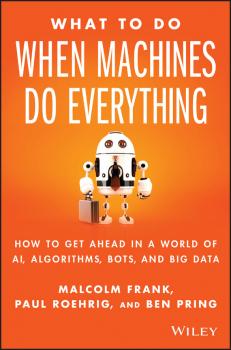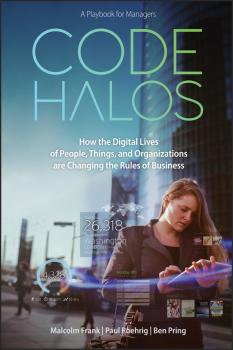ТОП просматриваемых книг сайта:
Malcolm Frank
Список книг автора Malcolm FrankWhat To Do When Machines Do Everything. How to Get Ahead in a World of AI, Algorithms, Bots, and Big Data - Malcolm Frank
Аннотация
“Refreshingly thought-provoking…” – The Financial Times The essential playbook for the future of your business What To Do When Machines Do Everything is a guidebook to succeeding in the next generation of the digital economy. When systems running on Artificial Intelligence can drive our cars, diagnose medical patients, and manage our finances more effectively than humans it raises profound questions on the future of work and how companies compete. Illustrated with real-world cases, data, and insight, the authors provide clear strategic guidance and actionable steps to help you and your organization move ahead in a world where exponentially developing new technologies are changing how value is created. Written by a team of business and technology expert practitioners—who also authored Code Halos: How the Digital Lives of People, Things, and Organizations are Changing the Rules of Business—this book provides a clear path to the future of your work. The first part of the book examines the once in a generation upheaval most every organization will soon face as systems of intelligence go mainstream. The authors argue that contrary to the doom and gloom that surrounds much of IT and business at the moment, we are in fact on the cusp of the biggest wave of opportunity creation since the Industrial Revolution. Next, the authors detail a clear-cut business model to help leaders take part in this coming boom; the AHEAD model outlines five strategic initiatives—Automate, Halos, Enhance, Abundance, and Discovery—that are central to competing in the next phase of global business by driving new levels of efficiency, customer intimacy and innovation. Business leaders today have two options: be swallowed up by the ongoing technological evolution, or ride the crest of the wave to new profits and better business. This book shows you how to avoid your own extinction event, and will help you; Understand the untold full extent of technology's impact on the way we work and live. Find out where we're headed, and how soon the future will arrive Leverage the new emerging paradigm into a sustainable business advantage Adopt a strategic model for winning in the new economy The digital world is already transforming how we work, live, and shop, how we are governed and entertained, and how we manage our money, health, security, and relationships. Don't let your business—or your career—get left behind. What To Do When Machines Do Everything is your strategic roadmap to a future full of possibility and success. Or peril.
Code Halos. How the Digital Lives of People, Things, and Organizations are Changing the Rules of Business - Malcolm Frank
Аннотация
Harness «Code Halos» to gain competitive advantage in the digital era Amazon beating Borders, Netflix beating Blockbuster, Apple beating Kodak, and the rise of companies like Google, LinkedIn, and Pandora are not isolated or random events. Today's outliers in revenue growth and value creation are winning with a new set of rules. They are dominating by managing the information that surrounds people, organizations, processes, and products—what authors Malcolm Frank, Paul Roehrig, and Ben Pring call Code Halos. This is far beyond “Big Data” and analytics. Code Halos spark new commercial models that can dramatically flip market dominance from industry stalwarts to challengers. In this new book, the authors show leaders how digital innovators and traditional companies can build Code Halo solutions to drive success. The book: Examines the explosion of digital information that now surrounds us and describes the profound impact this is having on individuals, corporations, and societies; Shows how the Crossroads Model can help anticipate and navigate this market shift; Provides examples of traditional firms already harnessing the power of Code Halos including GE's «Brilliant Machines,» Disney's theme park «Magic Band,» and Allstate's mobile devices and analytics that transform auto insurance. With reasoned insight, new data, real-world cases, and practical guidance, Code Halos shows seasoned executives, entrepreneurs, students, line-of-business owners, and technology leaders how to master the new rules of the Code Halo economy.


